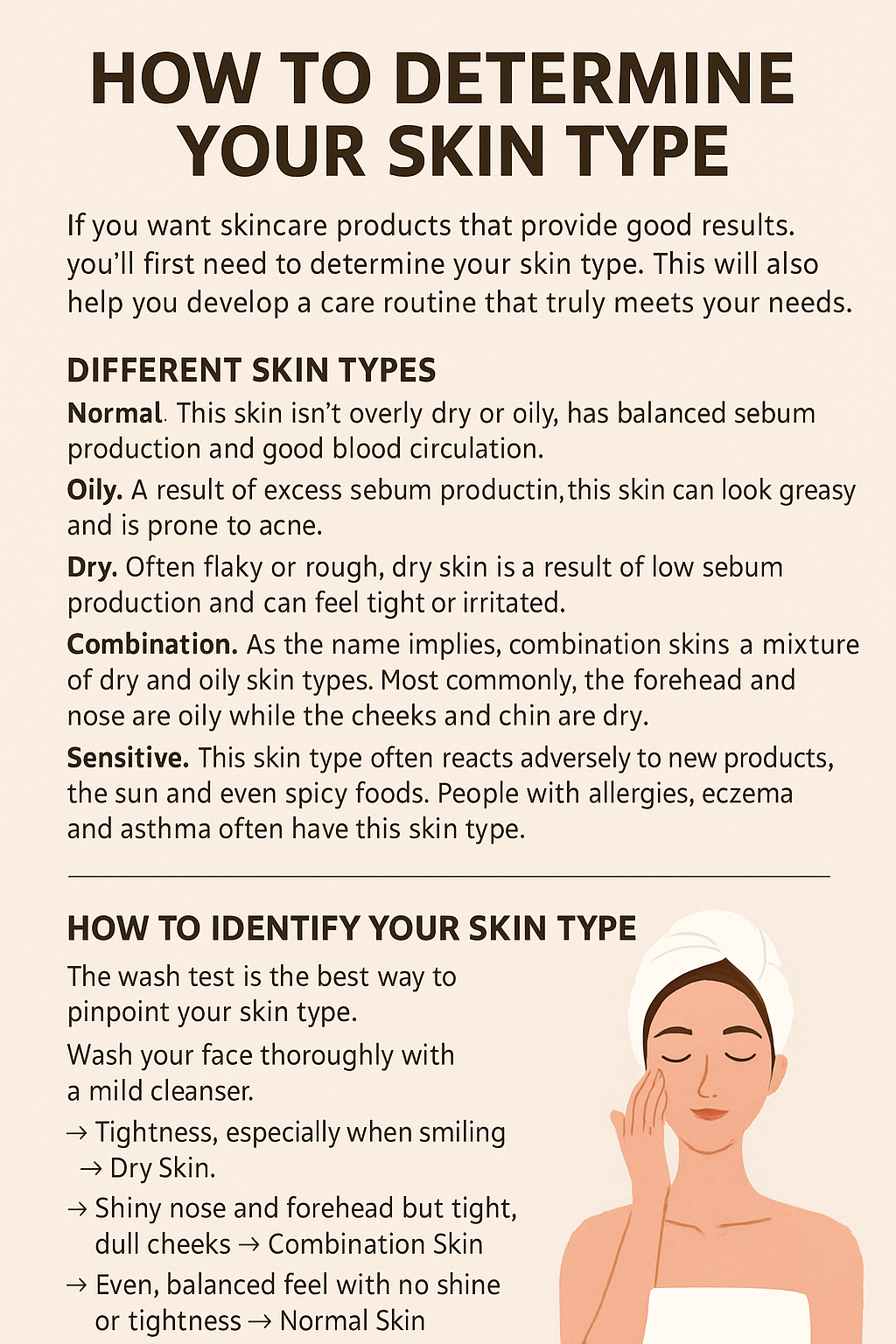
If you want skincare products that actually work (instead of piling up like unused gym memberships), you first need to determine your skin type. Why? Because your skin barrier, sebum production, and even pore size dictate which skincare routine and products will give results. Guessing here is like putting diesel in a Tesla — wrong fuel, wrong outcome.
Here’s everything you need to know about the different skin types, how to pinpoint your own, and why it matters for healthy, glowing skin.
Different Skin Types
There are five basic skin types — each with unique attributes, values, and care requirements. Recognizing them helps you avoid skincare disasters (like using a harsh toner on already dry skin).
- Normal Skin
Balanced oil production and good circulation. No excessive dryness or oiliness. Basically, the “best of” both worlds. - Oily Skin
Triggered by excess sebum from sebaceous glands. Appears shiny, prone to acne, blackheads, and enlarged pores. - Dry Skin
Low sebum levels → feels tight, often flaky, rough, or even itchy. Needs hydration and barrier repair. - Combination Skin
The ultimate “can’t decide” skin. Usually an oily T-zone (forehead + nose) with dry cheeks and chin. - Sensitive Skin
The drama queen of skin types. Easily irritated by products, UV rays, weather, or even spicy food. Often linked with eczema, allergies, or asthma.
How to Identify Your Skin Type
The simplest way is the Wash Test — a dermatologist-approved, no-cost experiment.
- Wash your face with a mild cleanser.
- Wait 30–60 minutes with no moisturizer or serum.
- Observe your skin texture, shine, and tightness.
Signs to watch for:
- Shiny all over + large pores → Oily Skin.
- Tightness, especially when smiling → Dry Skin.
- Shiny T-zone but dry cheeks → Combination Skin.
- Even, balanced feel with no extremes → Normal Skin.
Pro tip: A blotting paper test can also reveal oil levels by dabbing your forehead, nose, and cheeks.
Visit a Medical Spa to Learn More
Still unsure? A dermatologist or medical spa professional can provide advanced skin analysis tools (like digital skin scanners) to evaluate your hydration, oil levels, and sensitivity thresholds.
At Canadian Beauty College, you can:
- Book a consultation with a cosmetology student or licensed professional.
- Try a specialized facial tailored to your skin profile.
- Learn how to pick the best products for your unique skin classification.
Beyond Skin Type: Professional Treatments
Once you know your skin type, the right care unlocks better results. At our GTA campuses, we offer:
- Facials customized by skin type (hydrating, clarifying, barrier-repair).
- Botox for fine lines and wrinkles.
- Massage therapy to improve circulation and relaxation.
- Makeup consultations to match your skin tone and condition.
📞 Call us today to schedule your appointment and experience professional care that actually matches your skin’s needs.
Why This Matters
Knowing your skin type is the foundation of any skincare routine. Without it, you risk wasting money, irritating your skin, or accelerating issues like acne or premature aging.
✅ By identifying whether you’re oily, dry, combination, normal, or sensitive, you’ll:
- Choose the best moisturizer, cleanser, and sunscreen.
- Build a routine that balances oil and hydration.
- Avoid common mistakes (like over-exfoliating sensitive skin).
- Invest in treatments that bring real, long-term value.
You can do a simple wash test. Cleanse your face with a mild cleanser, leave it bare for 30–60 minutes, then check:
Shiny all over → Oily skin
Tight and dry → Dry skin
Shiny T-zone but dry cheeks → Combination skin
Balanced with no extremes → Normal skin
Red, itchy, or reactive → Sensitive skin
The five main skin classifications are:
Normal skin – balanced oil and moisture
Oily skin – excess sebum, shiny look, acne-prone
Dry skin – flaky, rough, tight feeling
Combination skin – oily T-zone, dry cheeks
Sensitive skin – easily irritated, prone to redness
Your skin type determines which products and treatments work best. Using the wrong routine can worsen problems like acne, dryness, or irritation. Identifying your type helps you:
Pick the best moisturizer, cleanser, and sunscreen
Create a routine that balances oil and hydration
Prevent long-term damage like wrinkles and breakouts
Yes. Skin type isn’t fixed — it can shift due to:
Aging (more dryness, less elasticity)
Hormonal changes (puberty, pregnancy, menopause)
Environment (humidity, cold weather, pollution)
Lifestyle factors (diet, stress, skincare habits)
If you’re unsure, yes. A dermatologist or skincare professional uses advanced tools (like hydration scanners and pore analysis) to give accurate results. They can also recommend personalized treatments such as facials, barrier repair, or acne care based on your exact skin profile
